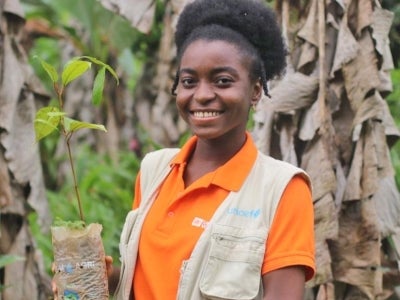
Photo courtesy of Iñaki Rodríguez
Iñaki Rodríguez is an assistant task manager working in the UN Environment Programme’s GEF Chemicals and Waste Unit. In an interview, he shared lessons from his work to protect people and the environment from the toxic effects of mercury poisoning, with a focus on artisanal and small-scale gold mining.
What does your work entail?
I am responsible for designing and managing GEF-financed projects related to the Minamata Convention on Mercury, an international environmental agreement focused on reducing the risks from mercury use and pollution.
Mercury is very harmful to both human health and the environment and is almost impossible to clean up once it has been released. In artisanal and small-scale mining, mercury is frequently used to separate gold from sediment, despite its substantial risks.
The GEF-funded planetGOLD program, which UNEP leads along with Conservation International, UNDP, UNIDO, and the Minamata Convention on Mercury, is working to make this sector safer, cleaner, and more profitable by helping small-scale miners adopt alternative techniques and processes that make mercury use unnecessary.
How did you get into this area?
I first became interested in artisanal and small-scale gold mining while working at the Embassy of Spain in Kenya. I was asked to analyze the state of mining in East Africa, and on delving into the environmental consequences of mineral extraction, I was completely captivated by the profound impact the industry had, not only on miners but on the broader environment. From there, I moved to UNIDO to work on artisanal and small-scale gold mining projects in Colombia, Mongolia, the Philippines, and other countries, and help raise awareness about the extent of mercury pollution emerging from this activity in multiple geographies.
What has surprised you most about mercury?
Mercury pollution can be subtle and hard to see at first, unlike other types of pollution or environmental degradation that are extremely overt. I’ve been to pristine tropical forests, far from mining sites, which are completely devastated by mercury contamination. Yet even in these sites, attributing the effects of mercury pollution to its source can be difficult without awareness-raising. Effectively communicating this issue to the general public presents a unique set of challenges, made difficult by underreporting.
While the environmental impact of mining operations is usually evident—extensive earth disturbance, deep excavations, and the destruction of local flora—mercury use complicates the picture. To see the effects, you can observe the corrosion of buildings and equipment at mining sites, particularly structures with metal ceilings. These ceilings often display small holes caused by mercury vapor corrosion when mercury amalgam is burned.

Photo credit: United Nations Environment Programme
In contrast, the effects of mercury poisoning in waterways are unmistakable. Water bodies can be contaminated when miners discharge used water into rivers or when leakages from water tanks filter contaminated water into the ground. Signs of mercury pollution include elevated mortality rates among local fish populations and increased water turbidity or cloudiness. Additionally, the quality and quantity of nearby crops can be impacted by mercury, a significant concern in low-income countries where artisanal miners often rely on subsistence agriculture to feed their families. If mercury is introduced near local villages, issues related to food access tend to emerge soon after.
Mercury also bioaccumulates in the food chain, leading to elevated mercury levels in the blood of local people who consume contaminated fish, meat, or vegetables. This accumulation can result in severe health deterioration, and in some cases results in Minamata Disease, a poisoning of the nervous system.
What are some of the biggest challenges ahead?
The transition to renewable energy, including major investment in electric vehicle batteries and solar panels, will increase demand for gold on a global scale. Ensuring this doesn’t lead to a surge in uncontrolled mining operations is a priority, as this would most likely be accompanied by increased use of dangerous chemicals. We cannot afford a transition that further damages the environment and harms human health.
Another issue that isn’t discussed enough is the impact of chemical pollution on biodiversity hotspots, such as the Congo Basin. Interventions to tackle both problems simultaneously exist, and we need to ensure that we address challenges in a holistic way. We need a systems mindset to tackle interconnected crises.
What gives you hope?
The Minamata Convention is relatively young, signed only a decade ago, and it has managed to capture the attention of not only governments but also the private sector. I am excited to continue to build on this momentum, as collaborative efforts involving key actors along the gold supply chain can drive further improvements in responsible gold production. The planetGOLD program, for instance, is helping organizations like the Swiss Better Gold Initiative, London Bullion Market Association, and World Gold Council move away from a “no questions asked” approach when sourcing their gold, improving mining operations on the ground. We are working every day to build a better sector and help people and the planet in the process, and this gives me tremendous hope.


